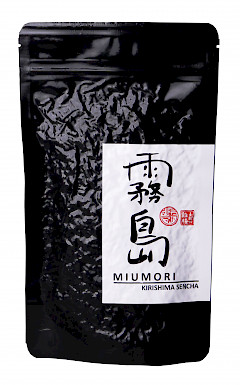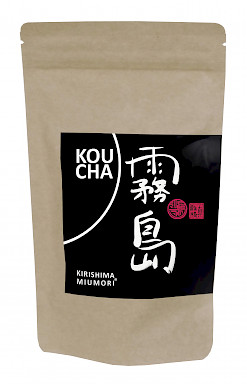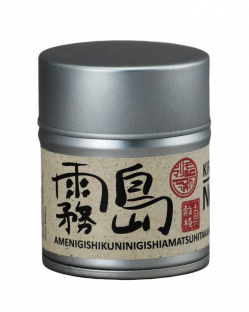MARIMO tea - Manufacture, Import & Wholesale
KIRISHIMA REGION, KYUSHU: THE ORGANIC TEA GARDEN OF SHUTARO AND KENJI HAYASHI
Shutaro Hayashi is part of the fifth generation of the Hayashi family. Together with his father and his uncle he is currently running the family’s tea garden, which was founded in 1897 by Shutaro’s great-great-grandfather on top of a plateau at the foot of the Kirishima Mountains. Most of the family’s tea garden plots are situated on a vast area which is almost completely surrounded by forest. The family’s small building, in which the tea is processed, was built in a central spot amongst the relatively small teagarden plots. This creates very short routes of transportation for the freshly harvested tea leaves, which can then be processed without any traces of oxidation. A variety of different tea cultivars, e.g. Asatsuyu, Yabukita, Kanaya Midori and Zairaishu (seed grown tea bushes) are the foundation of a very facetted range of teas.

Shutaro’s father Osamu began with pesticide free cultivation in 1993 after his discomfort with the use of pesticides in tea cultivation grew each year. Shutaro’s father decided to switch to organic cultivation step by step. On the one hand the anxiety about negative health effects of spraying pesticides, which would linger for several days, and on the other hand the observation that the pesticides kept losing their intended effects with each application.

The teagarden’s fifth generation – Shutaro’s generation – grew up with organic cultivation methods in the teagarden and got used to the ecological way of cultivation and the challenges that are caused by these methods every day. Compared to the previous generation, which had to put many efforts into the transition to pesticide free cultivation, the fifth generation is in a situation in which organic cultivation methods are self-evident. This situation is also the potential for the creation of first class teas:
After graduating in tea studies (the focus of his agricultural sciences degree), Shutaro Hayashi returned to his family’s business. He became the person in charge of certain teas, including the Kirishima Tennen Gyokuro (tea bush varietal Asatsuyu), while his uncle is still in charge of most of the other tea sorts. Meanwhile, Shutaro’s father is focused on the implementation of an elaborate system for dealing with pests in an environmentally sound way. This gives Shutaro the freedom to make use of the knowledge he gained during his studies in aiming for the perfect tea. It is hardly surprising that he is mainly using the tea bush varietal Asatsuyu in this ambition, since the cultivar Asatsuyu is known for its natural sweetness and its fantastically green colour when infused.
Shutaro is able to make use of the rare tea varietal Asatsuyu thanks to his father’s knowledge of organic cultivation and the vast pool of experience the family was able to amass in five generations. In addition, he is also able to work with his family’s own processing site, which would not be available to a young tea farmer because of the high investment costs that would be necessary for such an undertaking. This is the ideal basis for Shutaro’s way of working, as he is able to think outside the box by re-evaluating the usual methods of processing and modifying the time periods and the temperature during steaming, rolling and drying the tea leaves.
Some of Shutaro Hayashi's tea varieties in the overview
 |
KIRISHIMA TOKUJOU SENCHA (organic) Leaves from non-shaded tea bushes as well as leaves from shaded tea bushes are part of this high end blend – mainly from the tea bush varietals Yabukita and Asatsuyu. While the Yabukita brings the roundness and sweetness, the varietal Asatsuyu brings the brilliantly fresh taste notes and a beautiful deep umami-sweetness. The final processing is especially noticeable: Both the fine final sorting and the precise final heating speak for the effort and labour that is invested into the teas from the first flush harvest. |
 |
MIUMORI KIRISHIMA SENCHA (organic) The Miumori Kirishima Sencha is a blend of comparably deep steamed leaves [fukamushi] and comparably flatly steamed leaves [asa-mushi], in the sense how strongly and intense the steam goes inside the leaves during the steaming process. The deeply steamed leaves give this tea a smooth roundness and sweetness, while the shorter steamed leaves bring an enjoyable flavour into the tea. At the same time, thanks to the blend of these two types of leaves, both, the 1st and the 2nd infusion are very delicious, because the opening time of both leaves types are not the same, when they get in contact with the warm water in the tea pot. |
 |
ASANOMI KABUSECHA KIRISHIMA MIUMORI (organic) In his organic tea garden, Shutaro Hayashi has planted two types of cultivars bearing the prefix ‘Asa’, which stand for ‘morning’: Asatsuyu and Asanoka. Both cultivars belong to Shutaro’s most favourite ones. They have soft and light characters, and a very fresh flavour. Asanomi Kabusecha is a balanced composition of these two impressive tea bush varietal. |
 |
YAMA OKU SENCHA KIRISHIMA MIUMORI (organic) "Yama Oku" means "deep in the mountains“ and refers to the location of Shutaro's tea gardens in the Kirishima mountain range, which rises to 1700 metres at its highest point. At the same time, the syllable "Oku" also alludes to the tea bush varieties Oku Yutaka and Oku Midori, which are predominantly used in this tea. Both tea bush varieties are sprouting at a comparatively late time in spring. This way, the young shoots can escape the night frost and grow undamaged. In addition to the two bush varieties already mentioned, Shutaro also uses a certain amount of the Yabukita variety, which was steamed a little deeper for this fine tea. The taste of Yama Oku is characterised by wonderfully creamy and velvety soft nuances and some umami. These come from the combination of the Oku Yutaka and Oku Midori varieties and are due to the very beautiful and fine grading, which is already known from Shutaro's teas in different grades. This is particularly pronounced in his first harvest teas. |
 |
KIRISHIMA MIUMORI KOUCHA (organic) (black tea) Shutaro Hayashi selected leaves from the cultivar varietal Benifuuki to develop this elegant and tasty black tea. It can be infused several times, with relatively short infusion times compared to black teas from other countries. |
 |
KIRISHIMA MIUMORI MIZUCHA® (organic) In Japanese, "mizu-dashi-cha" basically refers to infusing tea with cold water. However, the new word "mizu-cha" refers to tea that has been specially designed for brewing with cold water. Shutaro Hayashi from Kirishima uses the finest leaves mainly from the shaded bush varietal Asatsuyu and the unshaded bush varietal Yabukita. To complete the composition, Shutaro supplements this Mizucha® with a small amount of Matcha from the shaded bush varietal Kanaya Midori. |
 |
The tea bush cultivar Asatsuyu is known as one of the most green and fresh tasting tea bush varieties, which can only be found in few tea gardens, since it is not easy to grow these sensible tea bushes. Especially in organic agriculture the Asatsuyu bushes are extremely rare, which is why we are happy to have found this brilliant tea from the Hayashi family. |
 |
KIRISHIMA MIDORI MATCHA (organic) Shutaro Hayashi's Midori Matcha was gently ground from leaves of the tea bush varietal Kanaya Midori. Before harvesting, the tea bushes were shaded for a long time, so that the leaves have acquired an intense green color. This is where the name of the tea comes from: "Midori" is the Japanese word for an intense green. The Kanaya Midori varietal is accordingly known for its intense leaf color. Therefore, this tea is both pure, e.g. whipped with a bamboo whisk in a matcha bowl, but also for mixed drinks a pleasure. |
 |
NOMIKOTO – KIRISHIMA MATCHA (organic) The Nomikoto Matcha is a good quality, which is perfect to be enjoyed purely, prepared in a Matcha bowl with a Chasen. The dried leaves were milled to a very fine powder, which impresses by a soft feeling in the mouth. It has a quite nice Umami and sweetness, and is characterized be a relatively strong final heating [hi-ire]. This gives this Matcha a round sweetness, which is easy to understand. It is not too grassy and has less astringent taste than other Matcha. The leaves for this Matcha only stem from the 1st flush from Kirishima. |
 |
MIUMORI KIRISHIMA MATCHA (organic) The Miumori Matcha from Kirishima is a really high quality Matcha for Japanese tea ceremony, but still at a quite affordable price. It is a brilliant tea with lots of Umami and sweetness. |
|
|
The Dream of a Trip to Kyushu and the Way to the Tea of Kirishima
2006, when we first came to Japan for about two weeks, we just had the chance to visit some places on the biggest main island, Honshu. Our home base was the grandmother’s house of a friend, whom we knew from Berlin. There he was an exchange student one year before and in 2006 he invited us to visit him in Tokyo. It took all our money to buy the flight tickets and a Japan Rail Pass for travelling within Japan, so the budget was too small to pay for additional hotels. That is why we just made one-day trips from Tokyo. By train we travelled to Kyoto, Uji and also to Mie. At the train stations we saw wonderful pictures of Kyushu, Japan’s southernmost main island, and got the dream to go there. Indeed Kyushu was much too far away for a one-day trip.
It took about one year before we once again had the chance to travel to Japan and to finally see Kyushu. In Germany, we already had heard about tea cultivation in Kagoshima and in particular about the area of Kirishima, which made us come up with the idea of visiting a tea garden in that area. After riding the train for some hours from Honshu, we arrived in Kagoshima, where we looked for places in which Kirishima tea might have been grown on a map in the train station. We took another train headed for the Kirishima Mountains in the hopes of somehow finding a teagarden. We got completely lost. Only a hiking road into the mountains started at the station and on top of it all rain began to fall. But thanks to the rain on that day, we were able to meet Narieda Shinichiro and his unique ceramics. He told us that there was not a single tea garden to be found anywhere near his pottery workshop. Since that day we have visited Narieda each year and also started to explore the volcanic scenery of the Kirishima Mountains. We still have not found even one tea garden this way.

Seven years later, during the preparation of a university seminar on the identity and philosophy of founders of organic tea gardens, we came across a tea garden in Kirishima. The student working on this topic held a presentation on the ideas and the philosophy the Hayashi family held during their conversion to organic cultivation. This report got us interested in the passion Osamu Hayashi showed in restructuring his tea garden, during which he also convinced his brother and his son Shutaro of the ideals of organic tea cultivation.
Another year passed, before we finally had the chance to meet this family in person. As fellow green tea enthusiasts and advocates of organic agriculture, a tight bond swiftly formed between this family and us. We found a good friend in Shutaro Hayashi, Osamu’s oldest son, who is almost exactly our age and who also cannot imagine a life without green tea. Now, every time we are in Kirishima, we have not only formed the habit of visiting the ceramicist Narieda and going to an Izakaya (a smaller Japanese bar) together with Shutaro, but also to make short group trips to other tea gardens. Topics like Japanese tea cultivars, the facets of green tea processing and conversations about different preferences in taste are a vital part of our trips together. We are often listening intently to Shutaro’s explanations, which are not only based on experience, but also on the knowledge he gained while studying agriculture and tea cultivation at university. This makes the development of new teas one of many topics which connect us with Shutaro Hayashi.
